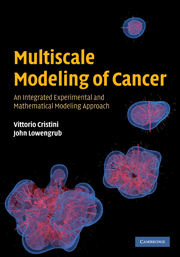9 - Continuum tumor modeling: a multidisciplinary approach
from Part II - Applications
Published online by Cambridge University Press: 05 October 2010
Summary
Introduction
In this chapter we describe recent multidisciplinary efforts that combine the models of cancer described in this book with laboratory experiments to model tumor growth and invasion. We focus on morphology, invasion, and anti-angiogenic therapy. The work has been accomplished in stages that progressively incorporate the complexity of the tumor environment: (i) the modeling of avascular tumors in vitro and in silico to assess the stages of tumor growth; (ii) the modeling of vascularized tumors in silico to assess the angiogenic switch and vascular growth; (iii) the modeling of vascularized tumors in vivo and in silico to assess tumor progression in the body.
Avascular growth
Even though in vitro conditions offer tumor cells unlimited space for expansion and no interaction with the host environment, the study of tumor growth and invasion using a three-dimensional multicellular tumor spheroid in vitro model has provided novel insights. A spheroid can be viewed as a network of individual cells, each with its own proliferation potential. Growth of the spheroid is the outcome of the balance between individual cell proliferation and internal cohesive forces. Variations in spheroid growth rates and in the extent of central necrosis have been attributed to fluctuations in the oxygen and nutrient concentrations, and tumor growth characteristics in vitro and in vivo have been extensively modeled. Spheroids may have the complexity of self-organized dynamical systems, which are regulated by both environmental and internal noise.
- Type
- Chapter
- Information
- Multiscale Modeling of CancerAn Integrated Experimental and Mathematical Modeling Approach, pp. 185 - 205Publisher: Cambridge University PressPrint publication year: 2010



